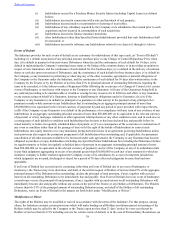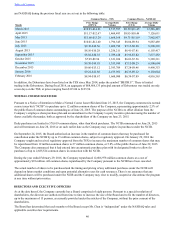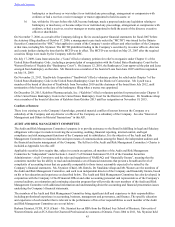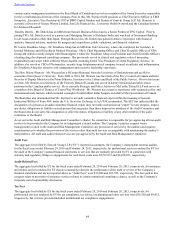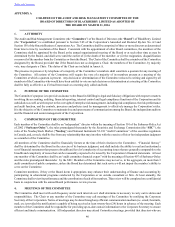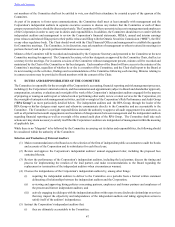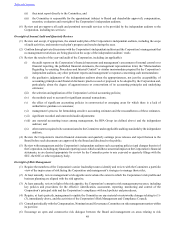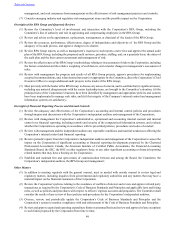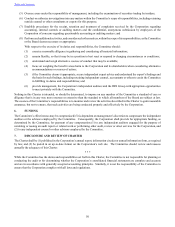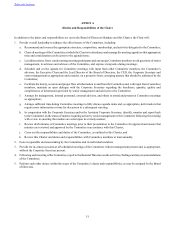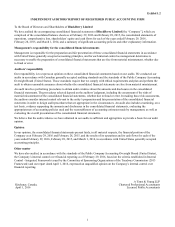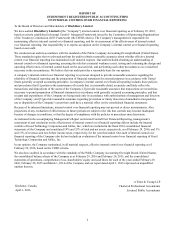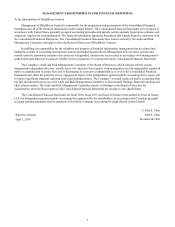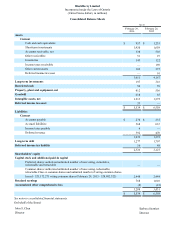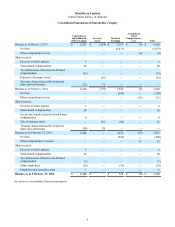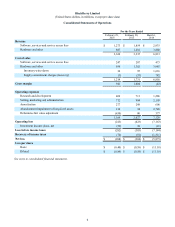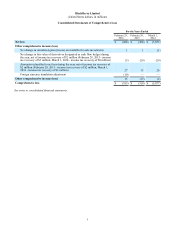Blackberry 2016 Annual Report Download - page 57
Download and view the complete annual report
Please find page 57 of the 2016 Blackberry annual report below. You can navigate through the pages in the report by either clicking on the pages listed below, or by using the keyword search tool below to find specific information within the annual report.
Table of Contents
48
(ii) they must report directly to the Committee; and
(iii) the Committee is responsible for the appointment (subject to Board and shareholder approval), compensation,
retention, evaluation and oversight of the Corporation’s independent auditors;
(6) Review and pre-approve all audit and permitted non-audit services to be provided by the independent auditors to the
Corporation, including tax services;
Oversight of Annual Audit and Quarterly Reviews
(1) Review and accept, if appropriate, the annual audit plan of the Corporation’s independent auditors, including the scope
of audit activities, and monitor such plan’s progress and results during the year;
(2) Confirm through private discussions with the Corporation’s independent auditors and the Corporation’s management that
no management restrictions are being placed on the scope of the independent auditors’ work;
(3) Review the results of the year-end audit of the Corporation, including (as applicable):
(i) the audit reports on the Corporation’s financial statements and management’s assessment of internal control over
financial reporting, the published financial statements, the management representation letter, the “Memorandum
Regarding Ac-counting Procedures and Internal Control” or similar memorandum prepared by the Corporation’s
independent auditors, any other pertinent reports and management’s responses concerning such memorandum;
(ii) the qualitative judgments of the independent auditors about the appropriateness, not just the acceptability, of
accounting principles and financial disclosure practices used or proposed to be adopted by the Corporation and,
particularly, about the degree of aggressiveness or conservatism of its accounting principles and underlying
estimates;
(iii) the selection and application of the Corporation’s critical accounting policies;
(iv) the methods used to account for significant unusual transactions;
(v) the effect of significant accounting policies in controversial or emerging areas for which there is a lack of
authoritative guidance or consensus;
(vi) management’s process for formulating sensitive accounting estimates and the reasonableness of these estimates;
(vii) significant recorded and unrecorded audit adjustments;
(viii) any material accounting issues among management, the RPA Group (as defined above) and the independent
auditors; and
(ix) other matters required to be communicated to the Committee under applicable auditing standards by the independent
auditors;
(4) Review the Corporation’s interim financial statements and quarterly earnings press releases and report thereon to the
Board before such documents are approved by the Board and disclosed to the public;
(5) Review with management and the Corporation’s independent auditors such accounting policies (and changes therein) of
the Corporation, including any financial reporting issues which could have a material impact on the Corporation’s financial
statements, as are deemed appropriate for review by the Committee prior to any year-end or quarterly filings with the
SEC, the OSC or other regulatory body;
Oversight of Risk Management
(1) Require the members of the Corporation’s senior leadership team to identify and review with the Committee a portfolio
view of the major areas of risk facing the Corporation and management’s strategies to manage those risks;
(2) At least annually, review management’s risk appetite and evaluate the extent to which the Corporation’s risk profile and
business planning are aligned with the risk appetite;
(3) At least annually, review in light of the risk appetite, the Corporation’s enterprise risk management processes, including
key policies and procedures for the effective identification, assessment, reporting, monitoring and control of the
Corporation’s principal risks and the Corporation’s compliance with such policies and procedures;
(4) Require, at least quarterly, management to update the Committee on any material or noteworthy changes relating to (1)-
(3), immediately above, and the activities of the Corporation’s Risk Management and Compliance Council;
(5) Consult periodically with the Compensation, Nomination and Governance Committee on risk management matters within
its purview;
(6) Encourage an open and constructive risk dialogue between the Board and management on areas relating to risk


